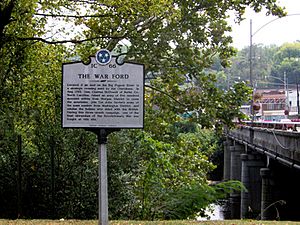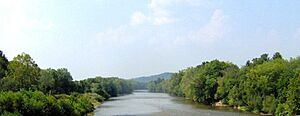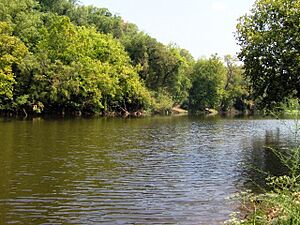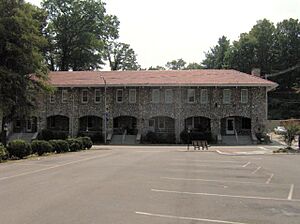Newport, Tennessee facts for kids
Quick facts for kids
Newport, Tennessee
|
||
|---|---|---|
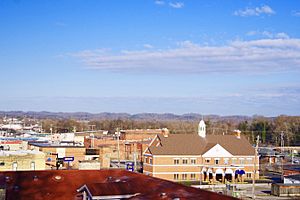
Downtown Newport
|
||
|
||

Location of Newport in Cocke County, Tennessee.
|
||
| Country | United States | |
| State | Tennessee | |
| County | Cocke | |
| Founded | 1799 | |
| Incorporated | 1867 | |
| Government
v
|
||
| • Type | Mayor-council | |
| Area | ||
| • City | 5.53 sq mi (14.33 km2) | |
| • Land | 5.53 sq mi (14.33 km2) | |
| • Water | 0.00 sq mi (0.00 km2) | |
| Elevation | 1,168 ft (356 m) | |
| Population
(2020)
|
||
| • City | 6,868 | |
| • Density | 1,241.28/sq mi (479.25/km2) | |
| • Urban | 11,293 | |
| Time zone | UTC-5 (Eastern (EST)) | |
| • Summer (DST) | UTC-4 (EDT) | |
| ZIP codes |
37821-37822
|
|
| Area code(s) | 423 | |
| FIPS code | 47-53000 | |
| GNIS feature ID | 2404374 | |
Newport is a city in Cocke County, Tennessee, United States. It is the main city and the county seat of Cocke County. In 2020, about 6,868 people lived there. Newport is located right along the Pigeon River.
Contents
History of Newport
Early Settlers and War Ford
Long ago, a path called the Great Indian Warpath went through what is now Newport. This path led to ancient Cherokee hunting grounds. The path crossed the Pigeon River at a spot called the "War Ford." This was a place where the river was shallow enough to walk across.
During the American Revolutionary War, the Cherokee people sided with the British. They sometimes attacked early European-American settlers in the area. In 1782, a group of soldiers led by General Charles McDowell and Colonel John Sevier fought against the Cherokee. Sevier crossed the Pigeon River at War Ford and attacked some Cherokee camped there. This was one of the last fights of the Revolution.
After the war, the first European-American settlers came to the Newport area. They settled near the important river crossings. Peter Fine started a ferry in the 1780s. In 1783, John Gilliland settled across from Fine's Ferry. Later, Emanuel Sandusky and Samuel O'Dell also settled nearby. Around the 1790s, the Gilliland family gave 50 acres of land for a town square and courthouse. This is how the town of New Port began.
For many years, settlers in Newport faced attacks from Cherokee crossing the mountains. To protect themselves, they built forts like Wood's Fort and McCoy's Fort. After a treaty in 1785, Cherokee influence in the area began to decrease. By 1800, attacks in Newport were much less common.
River Trade and Flatboats
The French Broad River flows about one mile north of Newport. This river connects to the Tennessee River, which then leads to New Orleans and the Gulf of Mexico. In the early 1800s, a man named William Faubion traveled all the way to New Orleans with a flatboat full of goods and returned safely. Since roads were bad, river travel was a good way to move things. "New Port" quickly became a busy trading center for flatboats.
William Garrett built a large home called Beechwood Hall near Fine's Ferry. Many travelers and religious leaders stayed there. During the War of 1812, Garrett sent eight flatboats filled with food and whiskey to the U.S. Navy in New Orleans.
In 1812, a big religious meeting was held in New Port's courthouse. The Zion Methodist Church was started that year. The Presbyterians built a church in the 1820s. New Port also had one of the first schools in the area, Anderson Academy, started in 1820. New Port officially became a town on October 19, 1812.
Because New Port was a busy trading spot on the edge of the frontier, it sometimes had problems with lawlessness. The town used old methods of justice, like a pillory and stocks, to punish people.
Newport During the Civil War
By 1834, New Port had about 150 people. It had stores, doctors, blacksmiths, and churches. A new brick courthouse was built in 1828.
While slavery was not as common in East Tennessee as in other southern states, it did exist. Some buildings in Cocke County were built using slave labor.
When the American Civil War began in the 1860s, New Port tried to stay neutral. However, the town was often raided by both Union and Confederate soldiers. People would hide their valuables to keep them from being stolen. The people of Cocke County eventually formed a local guard to protect themselves from these raids.
Logging Boom and Alexander Arthur
In the late 1800s, there was a huge demand for wood. Logging companies started looking to the forests of Southern Appalachia. In 1880, a businessman named Alexander Arthur came to Newport. He planned to cut down trees in the Pigeon valley.
Arthur wanted to build dams and booms to float logs down the river to Knoxville. He built a fancy house in Newport and had big plans for the town.
The people of Newport warned Arthur about how quickly the Pigeon River could flood. In the spring of 1886, heavy rains caused the river to become a raging flood. Arthur's dam broke, and all his logs were washed away. His business failed. After this, Alexander Arthur moved away.
Newport in the 1900s
By the 1890s, Newport's population grew to 900. Even after Arthur's logging business failed, other industries came to town. In 1895, the A.C. Lawrence Leather Company opened a large tannery in Newport. A few years later, the Stokely Brothers Company started canning vegetables grown in the area.
Ben Hooper, who was from Newport, served as the governor of Tennessee from 1911 to 1915.
Carson Springs, a few miles southwest of Newport, became an early tourist spot. People believed the mineral springs had health benefits. The creation of the Great Smoky Mountains National Park in 1934 brought more tourists to Newport.
Kiffin Yates Rockwell, born in Newport in 1892, became a famous pilot in World War I. He was the first American pilot to shoot down an enemy plane while flying with the Lafayette Escadrille for France.
Geography and Location
Newport is located in western Cocke County. It sits along the Pigeon River. This area is where the foothills of the Great Smoky Mountains meet the French Broad River area. English Mountain is to the southwest, and Hall Top Mountain is to the southeast. The Pigeon River flows between them. The Great Smoky Mountains National Park is about 15 miles south of Newport.
The French Broad, Nolichucky, and Pigeon rivers all meet about 10 miles northwest of Newport. This area is now part of Douglas Lake, which was created in the 1940s. The French Broad River eventually joins the Holston River in Knoxville to form the Tennessee River.
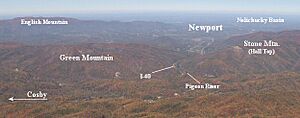
Several major highways meet in Newport. Interstate 40 goes through the southern part of the city. U.S. Route 321 comes into Newport from the south. U.S. Route 411 and U.S. Route 70 merge and enter Newport from the west. These roads help connect Newport to other towns and cities.
Newport has different parts based on its history. The main part of town, with the courthouse, is on the south bank of the Pigeon River. "Oldtown," north of the main section, was the original main area before the railroad came. A newer part of town has grown along US-321.
The city of Newport covers about 14.3 square kilometers (5.5 square miles) of land.
Population Information
| Historical population | |||
|---|---|---|---|
| Census | Pop. | %± | |
| 1870 | 281 | — | |
| 1880 | 347 | 23.5% | |
| 1890 | 658 | 89.6% | |
| 1900 | 1,630 | 147.7% | |
| 1910 | 2,003 | 22.9% | |
| 1920 | 2,753 | 37.4% | |
| 1930 | 2,989 | 8.6% | |
| 1940 | 3,575 | 19.6% | |
| 1950 | 3,892 | 8.9% | |
| 1960 | 6,448 | 65.7% | |
| 1970 | 7,328 | 13.6% | |
| 1980 | 7,580 | 3.4% | |
| 1990 | 7,123 | −6.0% | |
| 2000 | 7,242 | 1.7% | |
| 2010 | 6,945 | −4.1% | |
| 2020 | 6,868 | −1.1% | |
| Sources: | |||
Newport's Population in 2020
| Race | Number | Percentage |
|---|---|---|
| White (non-Hispanic) | 5,987 | 87.17% |
| Black or African American (non-Hispanic) | 267 | 3.89% |
| Native American | 19 | 0.28% |
| Asian | 46 | 0.67% |
| Pacific Islander | 2 | 0.03% |
| Other/Mixed | 326 | 4.75% |
| Hispanic or Latino | 221 | 3.22% |
In 2020, there were 6,868 people living in Newport. There were 2,776 households and 1,692 families in the city.
Schools in Newport
Newport has several schools for students:
- The City of Newport runs Newport Grammar School.
- The Cocke County Board of Education manages Cocke County High School and Cosby High School.
- They also manage several elementary schools: Cosby, Northwest, Smokey Mountain, Parrottsville, Del Rio, Grassy Fork, Bridgeport, and Edgemont.
Sports Teams
Newport was once home to a Minor League Baseball team called the Newport Canners. They played in the Class D Appalachian League from 1937 to 1942. They also played in the Mountain States League from 1948 to 1950.
Historic Buildings in Newport
Newport has several old and important buildings:
- Beechwood Hall: Built in 1803, this historic home was added to the National Register of Historic Places in 1975.
- O'Dell House: Built in 1814, it was also added to the National Register in 1975.
- Cocke County Courthouse: This courthouse was built in 1930 and added to the National Register in 1995.
- Elm Hill: Built in the 1890s, it joined the National Register in 1975.
- Rhea-Mims Hotel: Constructed in 1925, this hotel was added to the National Register in 1998. In 2000, it was changed into a home for senior citizens.
- Cocke County Memorial Building: Built in 1931, it was added to the National Register in 1997.
- Newport Lodge #234 F&AM: This Masonic Lodge was built in 1875. It was the town's first school, called Newport Academy. It is still used as a Masonic Hall today.
Famous People from Newport
- Jake Crum (born 1991), a NASCAR driver.
- Wilma Dykeman (1920–2006), a well-known author and historian.
- Houston Fancher (born 1966), a college basketball coach.
- Ben W. Hooper (1870–1957), who served as the governor of Tennessee.
- L. D. Ottinger (born 1938), another NASCAR driver.
- Jimmy Owens (born 1972), a dirt track racing driver.
- James Henry Randolph (1825–1900), a U.S. congressman.
- Kiffin Yates Rockwell (1892–1916), a brave pilot from World War I.
- Pop-Boy Smith (1892–1924), a baseball pitcher.
- Marshall Teague (born 1953), a famous actor.
See also
 In Spanish: Newport (Tennessee) para niños
In Spanish: Newport (Tennessee) para niños



